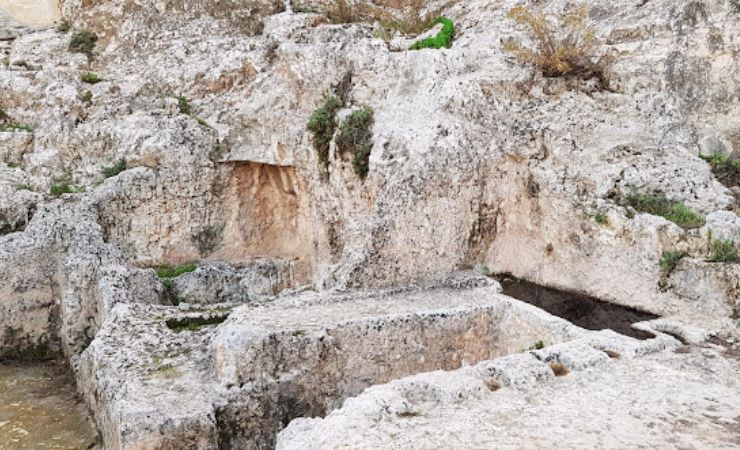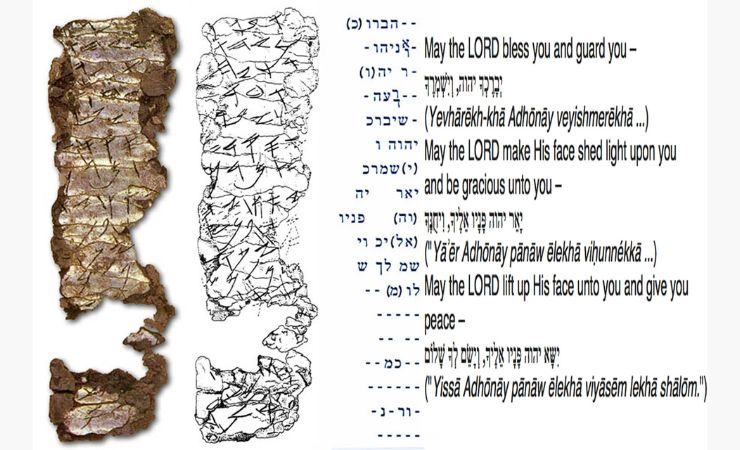Unearthing Ancient Secrets: Inside Ketef Hinnom's Burial Chambers
Excavations at Ketef Hinnom in the 1970s revealed a series of rock-hewn burial chambers based on natural caverns. These chambers date back to the Iron Age, specifically the 7th and 6th centuries BCE.

Location
Ketef Hinnom is strategically located southwest of Jerusalem’s Old City. Overlooking the picturesque Hinnom Valley, this site offers a panoramic view of the city’s ancient walls and historic landmarks.
Amulets with the oldest surviving texts from the Bible known to date
In 1979, while excavating near the outskirts of Jerusalem, close to St. Andrews church, Gabriel Barkay stumbled upon ancient burial caves at a place called Katef Hinnom. The caves have probably been in use for several generations from around 650 BCE, towards the end of the First Temple period, and continued to be used after the destruction of Jerusalem in 587/6 BCE.
Professor Barkay was assisted by a group of 12 and 13-year-olds who found the tombs had been emptied and looted in the past. One of the young helpers, Nathan, was assigned to clear dirt from beneath the burial benches in Chamber 25. In a youthful burst of energy, he struck a nook with a hammer, inadvertently uncovering a hidden chamber. This chamber held over 1000 artifacts, including 125 silver items, 40 iron arrowheads, glass bottles, needles, and treasures made of gold, ivory, glass, and bone. Additionally, there were 150 semi-precious stones and skeletal remains.
These artifacts were traced back to the late 7th and early 6th centuries BC, with two of the most notable finds being two tiny 1-inch silver scrolls (silver amulets).
The Silver Amulets of Katef Hinnom
The two small silver scrolls were no bigger than the diameter of a quarter and were originally worn as amulets around the neck.
It took more than three years to open them, but when researchers from the Israel Museum in Jerusalem finally unrolled small silver sheets 10 cm [nearly 4 inches] in length made out of pure silver, 99 % silver were revealed. On them, tiny lines of ancient Hebrew script inscribed on them were found.
High-resolution photos taken in 1994 by the West Semitic Research Project at the University of Southern California allowed researchers to study and decipher the Hebrew text on these ancient amulets.
The inscriptions on the amulets, which date back to the eighth–sixth centuries B.C.E., contained blessings similar to those found in Numbers 6:24–26 from the Hebrew Bible. These amulets contain the oldest surviving texts from the Hebrew Bible known to date.

Physical Description
- Amulet 1: When discovered, it measured 1 inch in height and 0.4 inches in diameter. When unrolled, it measured 3.8 inches in height and 1 inch in width.
- Amulet 2: Initially, it was 0.5 inches in height and 0.2 inches in diameter. When unrolled, it measured 1.5 inches in height and 0.4 inches in width. This scroll contained about 100 words arranged in 12 lines of text, inscribed on a silver sheet the length of a matchstick.
Significance and Interpretation
The amulets of Katef Hinnom provide insights into religion in ancient Judah. For instance, Amulet 1 refers to Yahweh as the one who shows graciousness to those who love him and keep his commandments, echoing sentiments found in several Biblical texts. Amulet 2 refers to Yahweh as the deity with the power to expel evil.



What's in the name?
The name “Ketef Hinnom” is Hebrew and translates to “Shoulder of Hinnom.” “Ketef” (כתף) in Hebrew means “shoulder.”
In geographical or topographical contexts, it’s often used to describe a slope or a ridge that resembles the shape or form of a shoulder. In the case of “Ketef Hinnom,” the name likely describes the specific topographical feature of the Hinnom Valley area that resembles a “shoulder” or a prominent ridge.
The Hinnom Valley, also known in the Bible and later Jewish and Christian traditions as Gehenna, is a location southwest of the Old City of Jerusalem. Historically, the valley was associated with idolatrous practices, including child sacrifices, during certain periods of ancient Israelite history. Over time, due to these associations, the term “Gehenna” (derived from the Hebrew “Ge-Hinnom,” meaning “Valley of Hinnom”) came to symbolize a place of judgment or hell in Jewish, Christian, and Islamic traditions.
Sources and addition reading
Katef Hinnom Silver Scrolls
Nearby Sites
King David’s Tomb: Located on Mount Zion, this revered site is traditionally believed to be the burial place of King David.
Room of the Last Supper: This ancient room is believed by Christians to be the site where Jesus had his Last Supper with his disciples.
Zion Gate: One of the eight gates in the walls of the Old City of Jerusalem, Zion Gate bears the scars of battles fought over the city.
- German Colony Jerusalem: A picturesque neighborhood established by German Templars in the 19th century.
- Scots Memorial Church (St. Andrew’s): Built as a memorial to the Scottish soldiers who died fighting the Turkish Army during the Sinai and Palestine campaign of World War I.
Montefiore Windmill: This windmill was built in the 19th century by Sir Moses Montefiore as part of his efforts to help Jews live outside the Old City walls.



